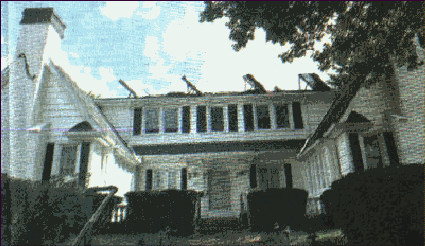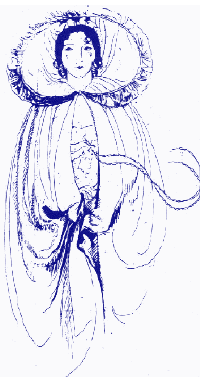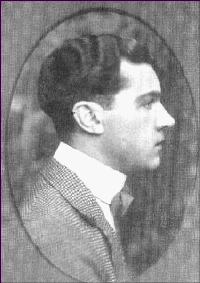
Late in the summer of 1996, the Shelby County Recorder's
office noted the purchase of a residence at 804 South Ohio Avenue (shown above) by Eric
and Holly Van Fossen. This home is once again for sale in 1999. Long-time Sidney residents
will recall that the house was always known as "The Chimneys." Built in 1914, it
was the residential masterpiece of its time. The house was the gift from a loving son,
Herman Patrick Tappe, to his mother, Anna. Herman Tappe, incredibly talented, and to some,
outlandishly peculiar, was at the center of the New York City social scene for four
decades. His life and the times in which he lived were the subject of much speculation by
his friends in Sidney, Ohio. This is his story.
At the height of his influence, Herman Tappe (or Hermon Tappe as he insisted on being
called), was the social advisor, interior decorator and wedding planner for many of the
'New York 400' - the most elite families in the city. The Rockefellers, Roosevelts and
Astors utilized his services. His buying trips to Paris each year resulted in ideas that
helped set fashion trends everywhere. His wealth grew commensurate with his power and
influence. It was quite an accomplishment for a man of such humble beginnings.
Herman was born into the world on June 20, 1876, the only son of
Herman F. and Anna Tappe. Herman Sr. operated a small cigar
company in Sidney. His first love was music, however. Tappe formed one of the original
civic bands in town. It was known simply as "Tappe's Band." Tragedy
struck the Tappe family in 1883, when he died of 'consumption' at the age of 33. Tappe's
band accompanied the body to Graceland Cemetery, New Orleans style. The editor of the Sidney
Journal commented: "His foibles, whatever they may have been, are covered
under the broad mantle of a music-loving people's charity." His son, Herman, was
only seven.
Anna was left alone to raise Herman and
three daughters, Mayme, Celia and Elizabeth. Anna would never remarry. A
closeness developed among all the family members that Herman would never
forget.
After graduating
from Holy Angels School, Herman worked in the millinery, or hat department
of the I. H. Thedieck store in Sidney for several years. Apparently, he
acquired a taste for the business. With two friends, he left Sidney for good
and moved to Chicago where he acceptd employment with Shane, The Furrier.
After gaining two years of additional experience, Tappe was ready to move
on. In 1900, he left for New York City.
Tappe took a job
with Wurzberger and Hecht, Wholesale Feathers and Flowers as a foreign
buyer. He began to develop an extensive network of contacts in Paris and
throughout Europe that would serve him well in later years. The Sidney
Journal noted in its May 26, 1905 edition that Tappe had "crossed the
Atlantic twelve times and feels at home on the rolling deep."
Fresh with ideas
from Paris and elsewhere, Herman Tappe opened up his own emporium in New
York City in May of 1907. At first, he specialized in ladies' hats. He
summoned sisters Celia and Mayme to join him, the former as bookkeeper and
the latter as a cutter of millinery fabric.
Tappe was
strikingly handsome. He did not last long as a bachelor. In the same year he
began his business, he married Ada Joffray McVickar, the daughter of one of
the leading clothing merchants in the city. Ada died in 1917.
Despite his high
expectations, Tappe's business went into bankruptcy in 1910. Within a short
time, however, he was back in business. He opened the House of Tappe' at 25
West 57th Street, taking over the former Lewison mansion. Hermon Tappe' was
back in business.
Although he was
immersed in the fashion business, Tappe never forgot the woman who was
dearest to his heart: his mother. In 1914, he journeyed to Sidney with a
noted architect from New York by the name of Hagen. He commissioned Hagen to
design a home for his mother. Built in the swiss chalet style by H. L.
Loudenbeck of Sidney, 'The Chimneys' represented the latest in architectural
ideas. Tappe spared no expense in decorating the yard with statuary imported
from southern France. Placed atop the house were two stone cats, which
legend has it safe-guarded the occupants of the home from evil spirits.
Anna Tappe lived there until she died in her 87th year.
Tappe quickly learned the value of publicity.
In 1918, while traveling through France and England on a buying trip, Tappe
was detained and accused by British agents of plotting to free Ireland. All
the New York papers carried the story. The agents broke open his luggage and
found silver and gold buttons from officers' uniforms, full dress regalia of
French admirals, and kilts of Scottish chieftains. Tappe claimed he was
going to "startle New York" that Fall with his fashion ideas. After telling
the authorities that Lady Paget would vouch for him, he was permitted to
leave.
He was the first to use
models in his business. One of the girls was Anna Holch. She was known throughout New York
City as 'the beautiful Anna.' She accepted his proposal for marriage, but Tappe wanted to
time the announcement to gain maximum effect. He hosted a grand ball at the armory in
Sidney in December of 1918 to celebrate the end of the First World War and announce his engagement. Over 600
people attended the social event of the season. The Shelby County Democrat reported
that Tappe brought in a jazz band and a colored orchestra from New York for the occasion.
Local folklore has it that Herman later redecorated some of 'The Chimneys' in blue to
match the striking blue eyes of Anna.
Over the next two decades, with Anna at his side,
Herman Tappe became the rage in ladies' fashions. In a book entitled The Ways of
Fashion, author M.D.C. Crawford hailed Tappe as a "designer of creative
imagination and authority," who "for a generation has been recognized as
an artist in costume by the most discriminating fashionables in the United States." Crawford credited him with being the first American designer to gain international
fame.
As his fashion ideas caught on, he became a regular contributor to such magazines as Harper's
Bazaar. Throughout his career he never lost his touch for publicity. In 1936, Tappe
created a stir when he suggested men should use hand fans to cool themselves in hot
weather. The New York Times quoted Tappe on July 12th as saying "American
men were so trammeled by convention that they hesitated to do anything to make themselves
comfortable in sweltering weather."
Herman Tappe never forgot his family and friends in Sidney. Each year, he would return
to spend up to a month with his mother. The arrival of Tappe was always a spectacle. He
had a chauffeured limousine that was equipped with a glass divider behind which Tappe sat.
Some Sidney residents recall Tappe strolling by the Spot Restaurant in a top hat and tails with a
silver-headed cane.
It was as a wedding gown designer and wedding advisor that Tappe earned his reputation
for brilliant and sometimes unconventional ideas. Some of Tappe's triumphs were chronicled
by author Gretta Palmer in a July 1939 article in Ladies Home Journal. His
measuring stick for success: "At a successful wedding, every woman present has a
good cry." Tappe insisted on doing all the dresses on the wedding party,
including the mother of the bride, in order to manage the overall effect. He wanted an
indrawn breath when the attendants approached, and a lump in the throat when the bride
made her appearance. In the early years when Tappe was only a milliner, he designed the
bridal veils for such famous brides as Mrs. Theodore Roosevelt, Jr. and Mrs. Vincent
Astor. As his client list and influence grew, Tappe began to manage the entire event.
Tappe loved to
choreograph the effect. For one wedding, the bride was escorted down the aisle by her pure
white Russian wolfhound. In another, the bride wore green - a first in America, according
to Tappe. When John D. Rockefeller III married, Tappe designed the dresses of the
bridesmaids in fuchsia to match the stained glass windows of the church.
Of great
concern to Tappe was what the bride should carry down the aisle. Depending on the
personality of the wife to be, or the theme of the wedding, Tappe would suggest a prayer
book, or a parasol, flowers, or even a silver fox muff. He convinced one bride to wear a
wedding crown made of silver wheat sheaves.
Herman Tappe would manage the wedding from beginning to end, and handle the occasional
crisis along the way. When the maid of honor in the wedding of General John 'Black Jack'
Pershing's son broke her ankle just before the ceremony, Tappe entwined a shepherd's crook
with flowers, and she made it down the aisle. After the Rockefeller wedding Tappe
described the mother of the bride's dress to the press as being the color of "dregs
of wine." When reminded they were all ardent prohibitionists, Tappe recalled: "The
dress became mulberry."
To the extent the family would let him, Tappe loved to create a theme to fit what he
perceived were the personalities of the parties. He recalled for the Ladies Home
Journal article his 'delphinium bride' wedding and the 'Botticelli' wedding. He staged
the famous Duke-St. George wedding in a medieval setting, with the bride wearing a
Guinevere-like white satin gown with a cloth of silver, and the attendants adorned in
clothes of gold.

The above wedding gown
design was created by Herman Tappe and featured in the June 1921 edition of Harper’s
Bazaar.
Tappe designed wedding dresses for many of America’s leading families, such
as the Rockefellers and the Astors.

Herman Tappe was
a friend and advisor to the rich and famous. He was a personal friend of President
Franklin Roosevelt. The former queen of Spain once visited his place of business. Tappe
was also a confidant of Hildegarde, the famous nightclub and radio singer of the 1930's
and 40's. At the beginning of her career, he helped develop her trademark - long gloves
made to match each gown she wore. In a 1987 letter to William Ross, Jr., Hildegarde
commented that Tappe's contribution "was and is my image, even today!"
His
death in 1954 brought to an end a remarkable career. More than forty years after his
death, only 'The Chimneys' remains to remind us of
the artistry and style that was Herman Tappe.
[ Back to People Index ] |

